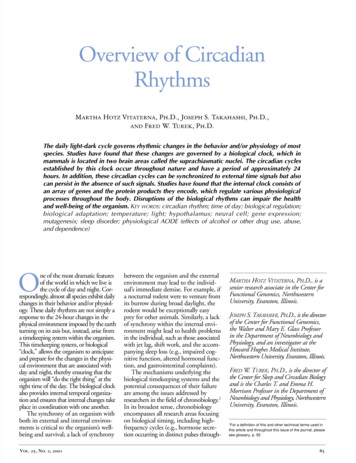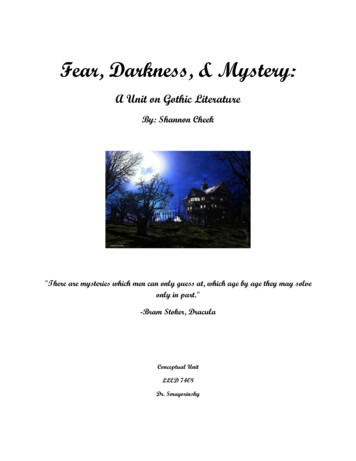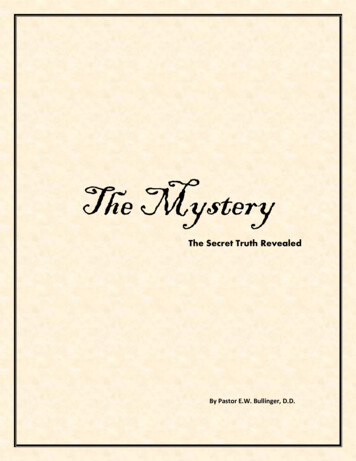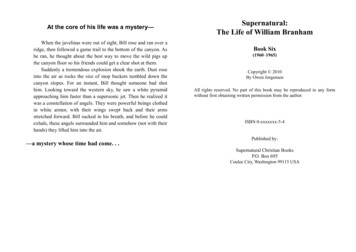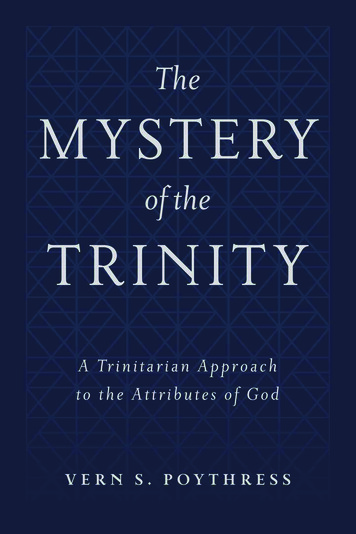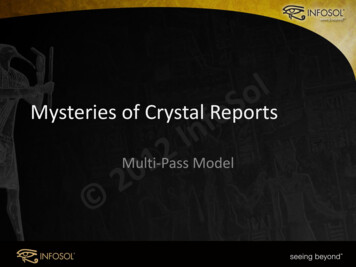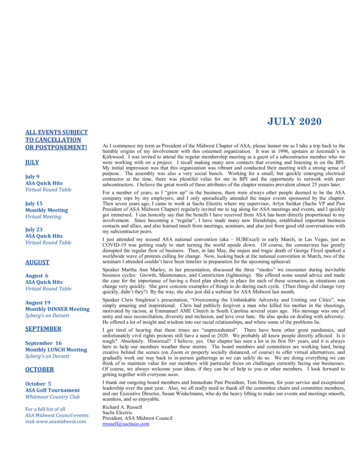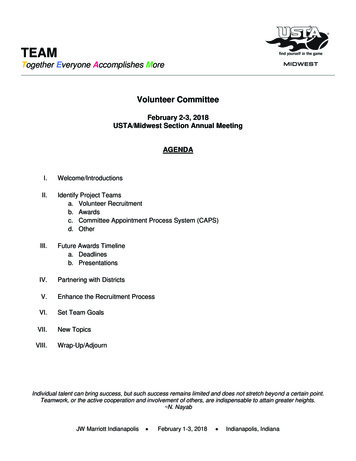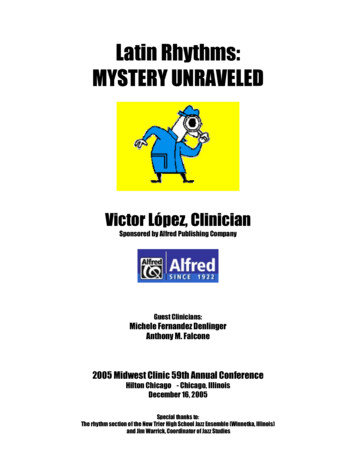
Transcription
Latin Rhythms:MYSTERY UNRAVELEDVictor López, ClinicianSponsored by Alfred Publishing CompanyGuest Clinicians:Michele Fernandez DenlingerAnthony M. Falcone2005 Midwest Clinic 59th Annual ConferenceHilton Chicago - Chicago, IllinoisDecember 16, 2005Special thanks to:The rhythm section of the New Trier High School Jazz Ensemble (Winnetka, Illinois)and Jim Warrick, Coordinator of Jazz Studies
Glossary of Latin Music TermsBOLERO (boh-LEH-roh) Is a Latin ballad and it is not to be confused with the Maurice Ravelcomposition of the same name. It is in the pretty slow tempo range but can sometimes haveopen vamps for improvisation that pick up in energy quite a bit, Such as in a Bolero-Son.BONGO (bohn-GOH) A small double drum (held between the knees, resting on the claves ofthe seated musician).CENCERRO - (sen-SEH-roh) A large hand-held cowbell played with a stick. It produces twonotes, depending upon where it is struck. In Cuban music and SALSA, it is usually played by thebongo artist when the band goes into the “ride” or MAMBO section after the main vocal. In goodhands, it can drive an entire band with ever-increasing excitement and power.CHACHACHA (cha-cha-CHA) Some claim that this is the second section of the DANZON;others argue that it is a slower MAMBO. It was sometimes called a double MAMBO in New Yorksince its basic dance step was the MAMBO with a double step in the fourth-to-firstbeats chachaCHA! The CHACHACHA developed around 1953 in the hands of CubanCHARANGAS. It was an elegantly hot music in its original flute-and-fiddle form.CHARANGA (cha-RANG-gah) A Cuban dance orchestra consisting of flute backed by two orthree fiddles, piano, bass and TIMBALES. CHARANGAS tended to play different dances fromthe Afro-Cuban CONJUNTOS, the most characteristic of which was the DANZON.CHARANGAS might range from large society units to small street bands. Modern CHARANGASuse the bongo and conga drums in the rhythm section and swing mightily in a light, precise,non-funky way.CIERRE (see-EH-reh) This is essentially a passage like a jazz break. The CIERRE can rangefrom a two-note bongo phrase to a complicated pattern for full band, more like a bridgepassage. Good CIERRES are fundamental to SALSA structure, but they are so varied and usedin so many ways that more precision of definition would be misleading.CLAVE (CLA-veh) An offbeat 3-2 or 2-3 rhythmic pattern over two bars, it is the basis of allCuban music into which all elements of arrangement and improvisation should fit. CLAVE is anAfrican-derived pattern with equivalents in other Afro-Latin music. African music has no singleequivalent of CLAVE, but much western and central African music is organized within an eightbeat frame which is the basis for many clave-like patterns, providing the underpinning forpolyrhythmic interplay. The common 3-2 Cuban CLAVE varies in accent, according to therhythm being played. It seems to be part of the inspiration for the two-bar bass pattern inmodern black music. The 2-3 reverse clave is less common.CLAVES Twin strikers of resonant wood used to play the CLAVE pattern.CONGA (COHN-ga) A major instrument in the SALSA rhythm section, the CONGA is literallythe Congolese drum derived from, and used by, the Afro-Cuban religious cults. There areseveral types of CONGAS: the small QUINTO, a solo improvising instrument; the mid-sizedCONGA, and the large TUMBADORA. The CONGA is capable of a great variety of soundsachieved through different ways of striking or rubbing the head and by raising the instrument,held between the knees, while playing it.CONJUNTO (con-HOON-toh) In U.S. terms, this could be translated to mean “combo”. Theclassic Cuban CONJUNTO sprang from the carnival marching bands and combined voices,Trumpets, Piano, Bass, Conga, and Bongo. Over the years, CONJUNTOS began adding a2
Trombone and, in New York, substituting Trombones for Trumpets. The basic CONJUNTOsound is brassy and joyous.CORO (COR-oh) The “chorus”. In SALSA, the two or three-voice refrains of two or four barssung during MONTUNOS. The lead singer improvises against the refrains. COROS are used invarious ways in arrangements: as reprises or, by an alteration of the refrain, to establish achange of mood.DESCARGA (des-CAR-gah) “Discharge” the slang of Latin musicians meaning jam session.GUAGUANCO (gwah-gwan-COH or wah-wahn-COH) African roots and was originally a drumform related to the RUMBA. Though it is often played in 4/4, it has a strong 6/8 feel. The basicrhythm is traditionally carried by three CONGA drums and usually includes a good deal of solodrumming. The modern GUAGANCO is one of the few 2-3 reverse CLAVE forms.GUARACHA (gwa-RAH-cha) The original Cuban GUARACHA was a topical song form forchorus and solo voice, with improvisation in the solo. It was presented in 3/4 and 6/8 or 2/4 timesignature. The GUARACHA developed a second section, employed for much improvisation, asin the SON MONTUNO. It almost died out in the 1930s but is today one of the forms mostcommonly used by SALSA groups; a fast, cheerful rhythm with a basic chica-chica pulse. Somemusicians credit its last section as the source for the instrumental MAMBO.GUIRO (GWEE-roh) Basically a scraper. The Cuban and Puerto Rican Guiro, often calledGuayo in Puerto Rico, is made from a notched gourd and played with a stick or fork-like scraper.The singer often plays it.GUIRA (Dominican Republic) the guiro’s metal counterpart- it is a characteristic instrument usedin merengue and is placed with a metal, fork-like stick.LATIN/JAZZ A hybrid of jazz and Latin music. Examples could range all the way from a Cubannumber with a few Louis Armstrong phrases to a straight jazz number with a CONGA drum. It ismost usefully confined to crosses with a Latin rhythm section, or those combining jazz and Latinelements and an instrumental frontline. Other fusions include Latin/Rock and Latin/Soul.MAMBO (MAHM-boh) an Afro-Cuban form, which has its basis in the Congolese religious cults.Though Perez Prado once claimed to have created it in 1943, its growth is not attributable toany single musician. The big band MAMBO of the 1940s and 1950s developed contrastingbrass-and-sax riffs, which many musicians regard as stemming from the last section of theGUARACHA.MAMBO SECTION A section of contrasting riffs for SALSA frontline instruments, balancingTrumpets against Saxes or Trombones for example. The section may also feature aninstrumental solo. Said to be derived from the GUARACHA, it got its name when it became amain part of the MAMBO during the late 1940s and early 1950s.MARACCAS (mar-RAH-kas) A tuned pair of rattles made from gourds filled from pebbles orseeds. It is one of a wide range of Amerindian-derived rattles.MERENGUE (meh-REN-geh) Originally from the Dominican Republic, this highlycommercialized dance form dates back to at least the early 19th century, the modernMERENGUE has a brisk, snappy 2/4 rhythm and a flavor quite different from the more flowingCuban dances.3
MONTUNO SECTION (mon-TOON-oh) A vehicle for improvisation (solo section). It is based ona two or three-chord pattern repeated ad-lib under the instrumental or vocal improvisations. Thepiano often maintains a repeated vamp.RUMBA (ROOM-bah) Most of what Americans call RUMBAS were forms of the SON whichswept Cuba in the 1930s. The Cuban RUMBA was a secular drum form with many variants,including the GUAGUANCO and the CUMBIA though modern musicians tend to regard all theseas separate. A highly African percussion-and-voice form, its descendent variations are the beheard by groups called RUMBAS or RUMBONES. By analogy, a percussion section of a SALSAnumber, or a percussion-only jam session, is sometimes called a RUMBA or RUMBON.SALSA (SAL-sah) A contemporary word for hot, up-tempo, creative Latin music, it means“gravy” or “sauce”. Originally, it was used as a descriptive such as “swinging” or “funky”. Theorigins of the present use are obscure, but it began to develop in the late 1960s. The style nowhas many other elements and SALSA is more precise than the earlier term, “Latin”.SHEKERE (SHAY-keh-reh) An African-derived rattle made from a gourd, covered with beads ina net-like pattern.SON (sohn) perhaps the oldest and certainly the classic Afro-Cuban form. Some date it back tothe 18th Century and place it in Oriente province. It is an almost perfect balance of African andHispanic elements in Cuban music. It surfaced in Havana around WW I and became a popularurban music played by string-and-percussion quartets and septets. Almost all the numbersAmericans called RUMBAS were, in fact, SONES, including “El Manicero” (“The PeanutVendor”). Technically, the song was a form of SON derived from the street cries of Havana andcalled a PREGON. The SON rhythm of is strongly syncopated, with a basic chicka-CHUNGpulse.SON MONTUNO (sohn mon-TOON-oh) A reverse CLAVE (2-3) form, usually mid-paced orslow, with a pronounced CHUNG-chicka feel. The SON MONTUNO developed as a separateform from the general SON tradition. Its rhythmic pulse is almost the exact reverse of a SON. Itwas, like the GUARACHA, one of the first forms to include a second, improvised section, theMONTUNO. Though it is not fast, the Afro-Cuban SON MONTUNO has an intense, relentlessquality highly suitable to the SALSA format.SONERO (soh-NEH-roh) In the strict sense, a man who sings or plays the Afro-Cuban SON, butthe word is now used for the improvising lead singer in the SALSA style. A good SONEROimprovises rhythmically, melodically, and verbally against the refrain of the CORO. Theimprovised phrases are known as INSPIRACIONES or, sometimes, SONEOS. Since theGUARACHA was also improvised, the word GUARACHERO is a synonym, though less used.SONGO (SON-goh) The Songo (along with some generic versions of the Mozambique) isprobable the most imitated Cuban rhythm throughout the world today. It is a unique blend ofRumba and Son styles integrated with funk/fusion and jazz style improvisation. The rhythmicpatterns are more syncopated and freer from repetition than the tumbao approach of the Sonstyles.TIMBALES (teem-BAH-less) A percussion set-up consisting of two small metal-single headeddrums mounted on a stand, with two cowbells, and very often a cymbal or other additions. Thetimbalero (timbale player) plays the “cascara” part on the shell. In the absence of timbales thedrummer plays the cáscara on the shell of the Floor Tom, on the Cymbals or the Hi-Hat.TUMBAO (Toom-BAH-oh) A repeated rhythmic pattern for bass (guitar) or conga drums. Itoffers a constant rhythmic counterpoint to the rhythms of the percussion section.4
TIPICO (TEE-pee-coh) An imprecise but extremely important concept in modern SALSA.Literally it means “typical” or “characteristic”, but it is more generally used to identify the downhome, rural, popular styles of Latin countries.(Excerpts from the AFRO-CUBAN RHYTHMS FOR DRUMSET by Frank Malabe and Bob Weiner, published by Manhattan Music,thInc. Distributed by CPP Media 15800 N.W. 48 Avenue, Miami, Fl. 33014 and Alfred Publishing (www.alfred.com)Brazilian Musical TermsA-go-go: a group of two or three bells joined together and played by striking with a stick andsqueezing, to create syncopation.Bossa Nova: a style of music created by acoustic guitar players singing and playing in thestreets of Rio. They are joined by percussion instruments, such as the ganza (shaker), andpandero (tambourine).Cabasa: (Afuche): a round coconut shell with small seashells strung around it with a handle.The updated version is a wooden cylinder with a metal cover with metal beads, played byrubbing the beads against the metal cover.Ciaxia: a metal snare drum, 3” x 14”, with the snares sometimes across the top head, using alarge drum sling to carry on the body.Cuica: a drum, with a skin at one end, either plastic or animal, with a stick attached. You play itby rubbing the stick through the open end with a wet rag or sponge. (No rosin or stickymaterial!)Ganza (shaker): a cylinder or square shaped cone with various material inside, from smallmetal pellets, to rice, (depending on sound), and played in a forward-backward shaking motion.Pandero (tambourine): a round thin drum with a skin and jingles played on the surface of thehead in a certain rhythm pattern. (See Brazilian patterns)Reco-Reco: The Brazilian version of the guiro or gourd, but made out of bamboo cylinders withgrooves and scraped with a thin stick.Repenique: small two-headed tenor drum played with a stick and using a large sling to carry onthe body.Samba: The Batucada is the most popular form of samba. Origin: basic African rhythm patternsstemming back to Angola. The Batucada is the rhythm pulse of the Escola de Samba, (sambaschool). There are approximately 8 or 9 different styles of samba.Surdo: a large bass drum, sized from 16” x 28”to 22” x 24”, using a large drum sling to carry onthe body. This instrument is played with a mallet and is the heartbeat and the pulse of thesamba.Tamborin: a small drum 6” in diameter played with a stick and held with the hand.5
Suggested ResourcesAretz, Isabel (Relatora de Libretos): America Latina En Su Musica Mexico: Siglo XXIEditores & Paris: Unesco, 1987.Dunscomb, J.Richard., & Hill, L. Willie: Jazz Pedagogy, The Jazz Educator’s Handbookand Resource Guide, Warner Bros. Publications, Distributed by Alfred PublishingCompany, P.O. Box 10003, Van Nuys, CA. 91410, 2002.Gerard, Charley w/ Sheller, Marty: Salsa, The Rhythm of Latin Music Crown Point, IN:White Cliffs Media Company, 1989.Malabe, Frank & Weiner, Bob: AFRO-CUBAN RHYTHMS for Drum Set, published byManhattan Music Publications, distributed by CPP Media, 15800 NW 48th Ave. Miami,Florida 33014 and Alfred Publishing Company (www.alfred.com), 1990.Mouleon, Rebecca: Salsa Guidebook for Piano & Ensemble Sher Music Co. 1993Patiño, Manny & Moreno, Jorge: AFRO-CUBAN Keyboard Grooves, published byWarner Bros. Publications and distributed by Alfred Publishing Company(www.alfred.com), 1997.Roberts, John Storm: The Lati
16.12.2005 · Latin Rhythms: MYSTERY UNRAVELED Victor L pez, Clinician Sponsored by Alfred Publishing Company Guest Clinicians: M ichele Fernandez D enlinger Anthon y M. Falcon e 2005 Midwest Clinic 59th Annual Conference H ilton C hicago - C


